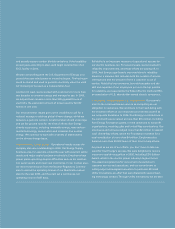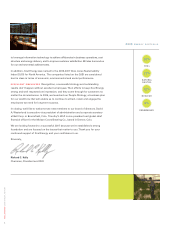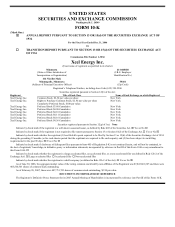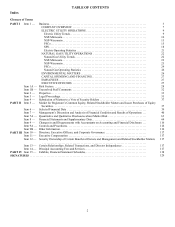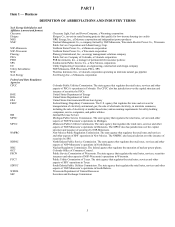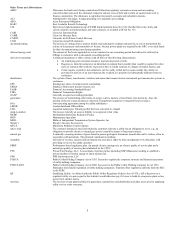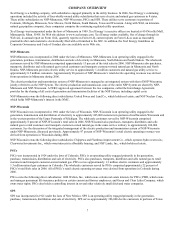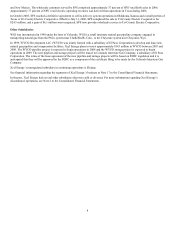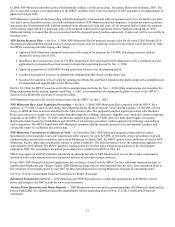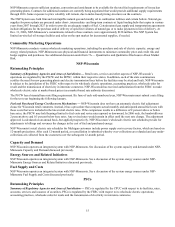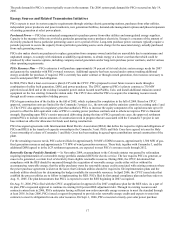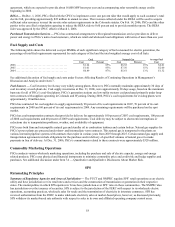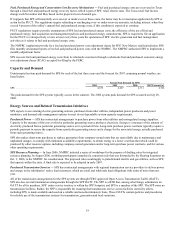Xcel Energy 2006 Annual Report Download - page 19
Download and view the complete annual report
Please find page 19 of the 2006 Xcel Energy annual report below. You can navigate through the pages in the report by either clicking on the pages listed below, or by using the keyword search tool below to find specific information within the annual report.9
ELECTRIC UTILITY OPERATIONS
Electric Utility Trends
Overview
Utility Industry Growth — Xcel Energy intends to focus on growing through investments in electric and natural gas rate base to meet
growing customer demands and to maintain or increase reliability and quality of service to customers. Xcel Energy has and plans to
continue to file rate cases with state and federal regulators to earn a return on its investments and recover costs of operations. For more
information regarding Xcel Energy’s capital expenditures, see Note 14 to the Consolidated Financial Statements.
Utility Restructuring and Retail Competition — The structure of the utility industry has been subject to change. Merger and
acquisition activity was significant as utilities combined to capture economies of scale or establish a strategic niche in preparing for
the future. The FERC has implemented wholesale electric utility competition, and the wholesale customers of Xcel Energy’s utility
subsidiaries can purchase from competing wholesale suppliers and use the transmission systems of the utility subsidiaries on a
comparable basis to the utility subsidiaries’ use to serve their native load.
Xcel Energy recognizes that local market conditions and political realities must be considered in developing its transition to
competition plan and a planned competition date for the Texas Panhandle. Given the current situation, Xcel Energy has been unable to
develop a plan for the Texas Panhandle to move toward retail competition that would be in the best interests of its customers. Xcel
Energy currently does not plan to propose to implement retail customer choice in the Texas Panhandle until required.
Xcel Energy does support the continued development of wholesale competition and non-discriminatory wholesale open access
transmission services. Xcel Energy will continue to work with the SPP on RTO development for the Panhandle region and the
incorporation of independent transmission operations to insure non-discriminatory open access. Xcel Energy is also still pursuing
strengthening its transmission system internally to alleviate north and south congestion within the Texas Panhandle and other lines to
increase the transfer capability between the Texas Panhandle and other electric systems.
Some states have implemented some form of retail electric utility competition. Much of Texas has implemented retail competition, but
it is presently limited to utilities within the Electric Reliability Council of Texas (ERCOT), which does not include SPS. Under current
law, SPS can file a plan to implement competition, subject to regulatory approval, in Texas. Xcel Energy does not plan to implement
competition until it is required. In 2002, NSP-Wisconsin began providing its Michigan electric customers with the opportunity to
select an alternative electric energy provider. To date, no NSP-Wisconsin customers have selected an alternative electric energy
provider.
The retail electric business does face some competition as industrial and large commercial customers have some ability to own or
operate facilities to generate their own electricity. In addition, customers may have the option of substituting other fuels, such as
natural gas or steam/chilled water for heating, cooling and manufacturing purposes, or the option of relocating their facilities to a
lower cost region. While each of Xcel Energy’s utility subsidiaries face these challenges, these subsidiaries believe their rates are
competitive with currently available alternatives.
Summary of Recent Federal Regulatory Developments
The FERC has jurisdiction over rates for electric transmission service in interstate commerce and electricity sold at wholesale, hydro
facility licensing, natural gas transportation, accounting practices and certain other activities of Xcel Energy’s utility subsidiaries.
State and local agencies have jurisdiction over many of Xcel Energy’s utility activities, including regulation of retail rates and
environmental matters. In addition to the matters discussed below, see Note 13 to the Consolidated Financial Statements for a
discussion of other regulatory matters.
FERC Rules Implementing Energy Policy Act of 2005 (Energy Act) — The Energy Act repealed PUHCA effective Feb. 8, 2006. In
addition, the Energy Act required the FERC to conduct several rulemakings to adopt new regulations to implement various aspects of
the Energy Act. Since Aug. 2005, the FERC has completed or initiated the proceedings to modify its regulations on a number of
subjects, including:
• Adopting new regulations by establishing rules for accounting procedures for holding company systems, including cost
allocation rules for transactions between companies within a holding company system;
• Adopting new regulations to implement changes to the FERC’s merger and asset transfer authority;
• Adopting new “market manipulation regulations” prohibiting any “manipulative or deceptive device or contrivance” in
wholesale natural gas and electricity commodity and transportation or transmission markets and interpreting this standard in a
manner consistent with Rule 10b-5 of the SEC; violations are subject to potential civil penalties of up to $1 million per day;
• Adopting regulations to establish a national Electric Reliability Organization (ERO) to replace the voluntary North American
Electric Reliability Council (NERC) structure, and requiring the ERO to establish mandatory reliability standards and


